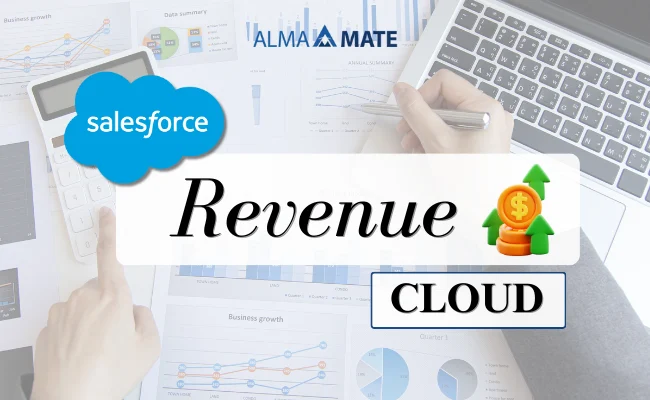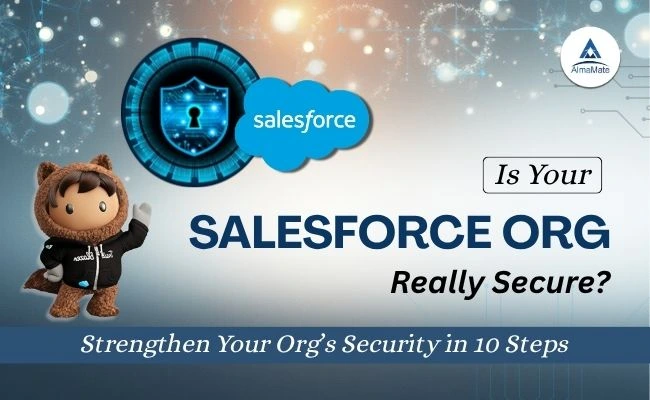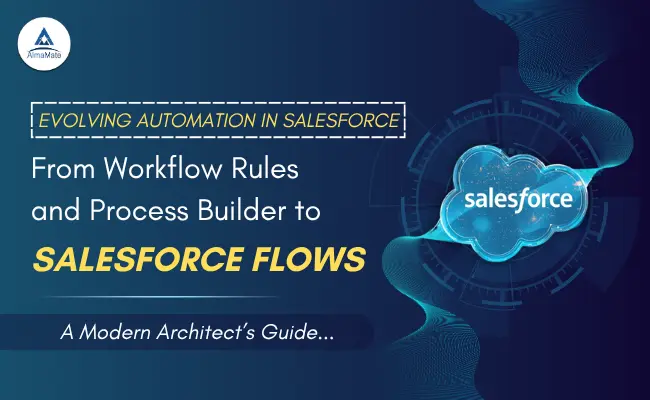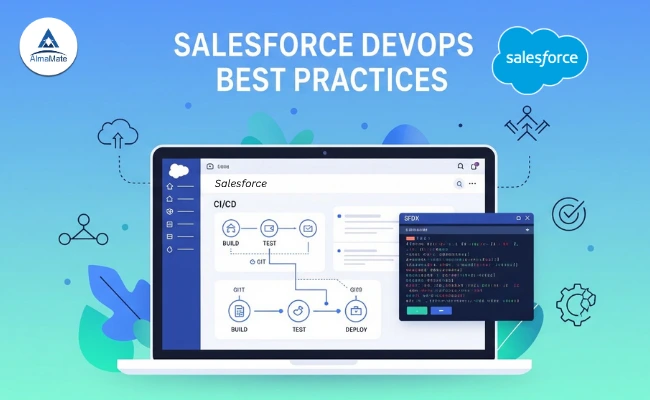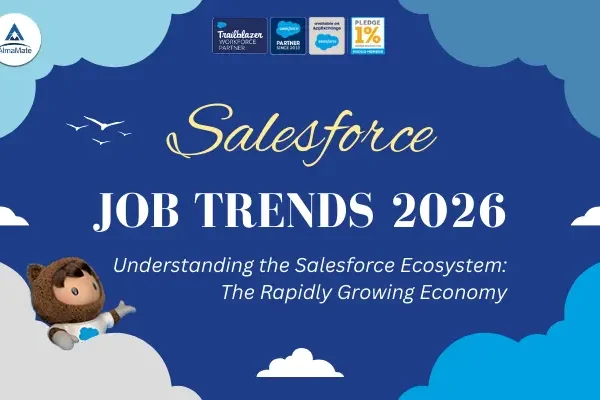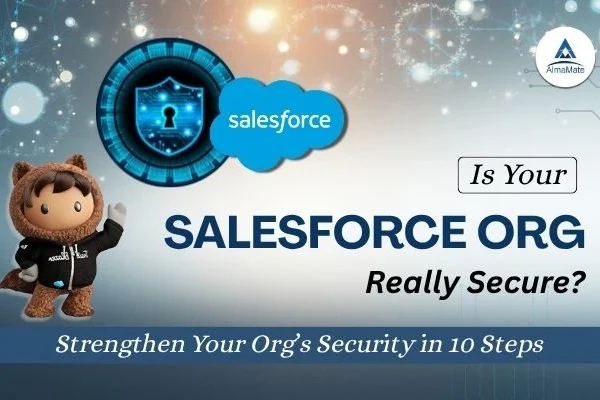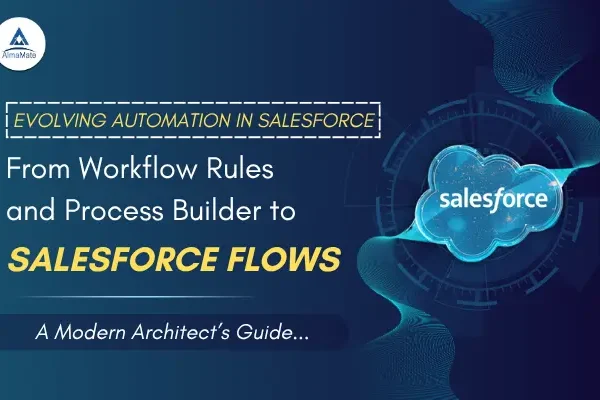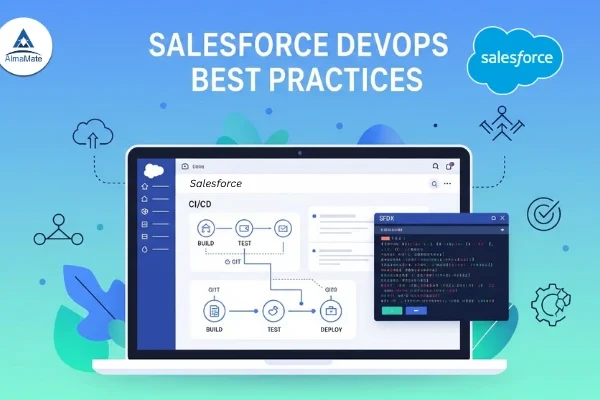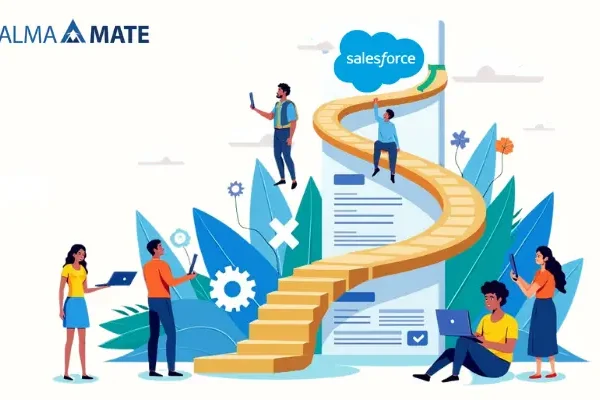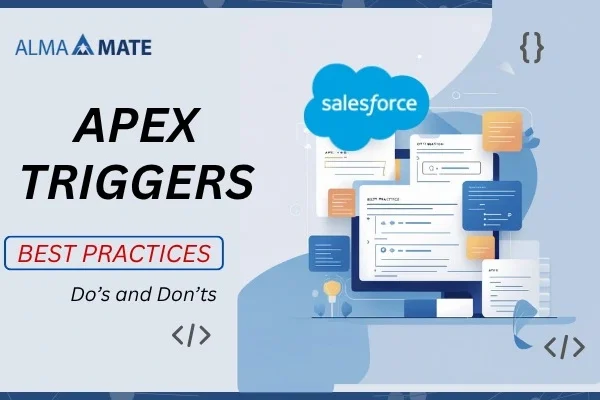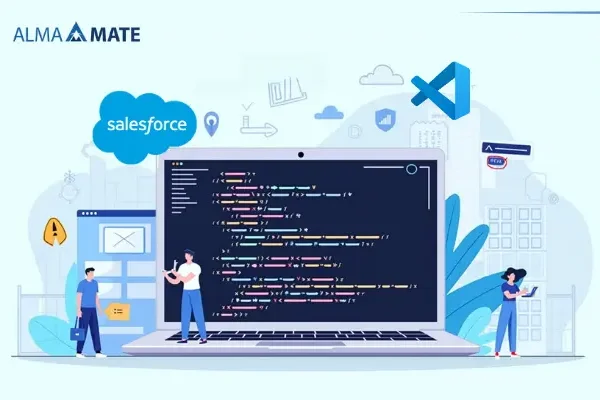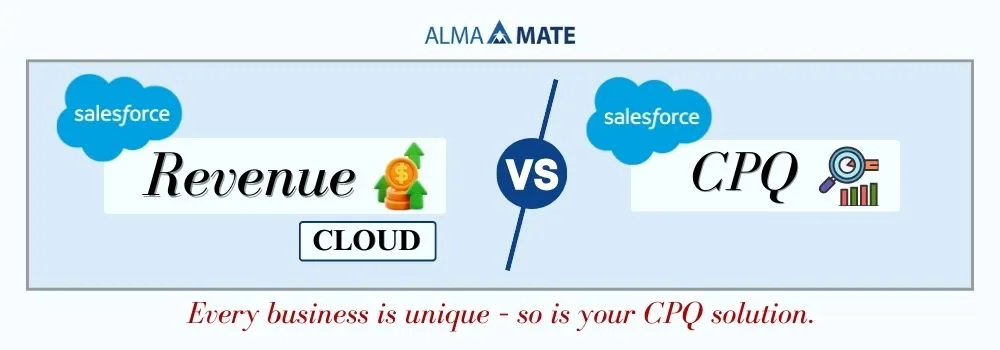
Table of Contents
Introduction
>> Brief overview of CPQ (Configure, Price, Quote) solutions
Here’s the deal—sales teams are stuck in this weird spot. Customers want things faster, more personalised, and basically custom-wrapped with a bow.
At the same time, what they’re selling is becoming increasingly complex. Products, pricing, bundles, you name it—it’s a jungle. CPQ tools swooped in as the heroes, promising to move those cursed spreadsheets and all the manual number-crunching that made everyone want to flip their desk: out of the picture.
But, you know, not all CPQ is created equal. The old-school stuff? It’s like trying to stream Netflix on dial-up. It worked for a bit, but now with everyone chasing subscriptions, juggling a million sales channels, and customers expecting Amazon-level service, the cracks are showing. Enter Salesforce Revenue Cloud: think of it as CPQ’s cooler, smarter cousin. It doesn’t just pump out quotes—it handles the whole money-making circus, from the first pitch to the final payment.
>> Why the Debate Between Revenue Cloud and Traditional CPQ Matters
This isn’t just some nerdy debate anymore—picking between old-school CPQ and Revenue Cloud is a real make-or-break move for companies looking to scale up, not just survive. So, yeah, we’re going to dive in and lay it all out: what’s good, what’s bad, and why so many companies are jumping ship.
Look, in today’s “blink and you’ll miss it” digital world, how you configure, price, and quote stuff is kind of everything. Customers don’t just want numbers—they want the whole experience to feel smooth, honest, and made just for them. Old CPQ systems helped for a while, cutting out some human screw-ups and making proposals less of a nightmare. But the world’s moving way too fast for that now. Businesses need something faster, smarter, and way more connected. That’s why Salesforce Revenue Cloud is suddenly the main character. It’s not just a quoting robot—it’s like the go-to tool for making money, helping companies actually keep up and cash in. Once you compare these, the switch validates itself.
What is Traditional CPQ: How It Works?
Old-school CPQ was built for a pretty basic problem: sales teams drowning in manual work, getting prices wrong, and having customers roll their eyes at slow, messy quotes. Before CPQ? It was all spreadsheets and chaos. CPQ came in, threw some automation on the mess, and made things at least bearable. Suddenly, salespeople weren’t tripping over invalid product combos or screwing up the math.
But those systems weren’t exactly built to grow with you. Integrations with CRM and ERP? Half-baked. Reporting? Not up to the mark/sub-standard at best. And forget about handling all the new subscription madness or complicated bundles people want now. If you’re selling one product, at one price, to one customer, then sure, old CPQ can do the job. But for everyone else? It’s starting to feel ancient.
>> Features and Capabilities
Here’s what traditional CPQ usually brings to the table:
- Product setup: Keeps reps from selling things that don’t even exist together. (No more “Can I get freebies with my software license?”)
- Automated pricing: Handles discounts and regional pricing.
- Quote docs: Generates decent-looking proposals while eliminating the need for hours of mundane copy-paste tasks.
- Approvals: Loops in the boss when discounts are promised excessively.
So yeah, it is a much better alternative to spreadsheets. Sales processes get faster, streamlined, and less error-prone.
>> Common Benefits for Businesses
Why Do Businesses Like It?
- Everyone plays by the same rules—no more rogue pricing.
- Deals close faster. No more “I’ll get you that quote next week.”
- Fewer embarrassing mistakes.
- Customers actually trust what you’re selling.
>> Limitations and Challenges
Here’s Where It Falls Flat
- Data is scattered everywhere. These systems never really played nice with the rest of your tech.
- Scaling is a headache. Adding new products or pricing rules? This does not help with scaling.
- Stops at the quote. Billing, renewals, revenue stuff? Cannot handle such requests.
- Analytics? Does not help with analytics (such as studying common trends) either.
Basically, it did the job when things were simple. Now? It’s showing its loopholes and limitations.
Salesforce Revenue Cloud: A Modern Approach
>> Overview of Revenue Cloud and how it fits within Salesforce
Revenue Cloud isn’t just a “new CPQ.” It’s a complete overhaul of the entire financial pipeline. Built right on top of Salesforce, it stitches together your CRM, billing, subscriptions, partners, analytics—the whole system and process tree. So, sales, finance, and service aren’t working from three different playbooks anymore. Everybody’s got the same info, in real time. No more “wait, who updated this?” drama.
It’s not just about getting a quote out the door. It’s about owning the whole revenue journey—start to finish. And honestly? That’s what companies need if they want to keep up.
>> Key Features and Integrations
What actually makes Revenue Cloud feel like it belongs in this decade. First off—it’s not just a tool for tossing out quotes and calling it a day. Revenue Cloud handles the entire financial process: from identifying what you’re selling, to sending the bill, to tracking renewals, and even managing the customer relationship long after the sale is complete. Old-school CPQ? Usually, you’d be juggling three different systems just to handle subscriptions or usage-based stuff. Revenue Cloud? Nah, it was built for that. Super flexible, so if you want to try out wild pricing models or suddenly make your business international, it won’t crash.
And yeah, it’s more than a quoting gizmo—it’s basically a revenue-boosting multi-utility tool that changes the game for how you pull in, manage, and stretch every dollar.
So, how does Revenue Cloud fit into the Salesforce world? It’s smack-dab in the middle of their Customer 360 features list. Instead of just generating quotes, it takes care of everything from the first handshake to cold, hard cash in your account. You get CPQ, billing, partner relationship stuff, and subscription management all tied together.
Since it’s built right on top of Salesforce, it plays nice with Sales Cloud, Service Cloud, Marketing Cloud…the whole system. The big deal? You stop thinking about customers as one-off sales and start seeing their whole journey, from the first pitch to a customer becoming a loyal repeat client.
Some stuff that stands out? Check this list:
- CPQ with brains: Smarter product picks, dynamic prices, and it steers sales reps in the right direction.
- Automated billing: Handles subscriptions, usage-based charges, and invoices—no human error involved.
- Revenue recognition: Stays on the right side of the accounting police (ASC 606, IFRS 15, etc.).
- Partner portals: Let resellers do their own quoting and deal management—less hand-holding for you.
- Analytics: Real-time dashboards, so you know where the cash is coming from (or not).
- Plays well with others: Super integration-friendly, hooks into your ERP and whatever else you’ve got.
>> Advantages: How it goes beyond Traditional CPQ
Why’s it better than the old gear? Well, instead of just generating a quote and praying everything else works, Revenue Cloud actually connects every dot from quote to collecting the cash. It smashes silos, keeps you compliant, and makes customers feel like you’re actually paying attention to their needs. It’s built for today’s wild business models—think subscriptions, global sales, dynamic pricing, all that fun stuff.
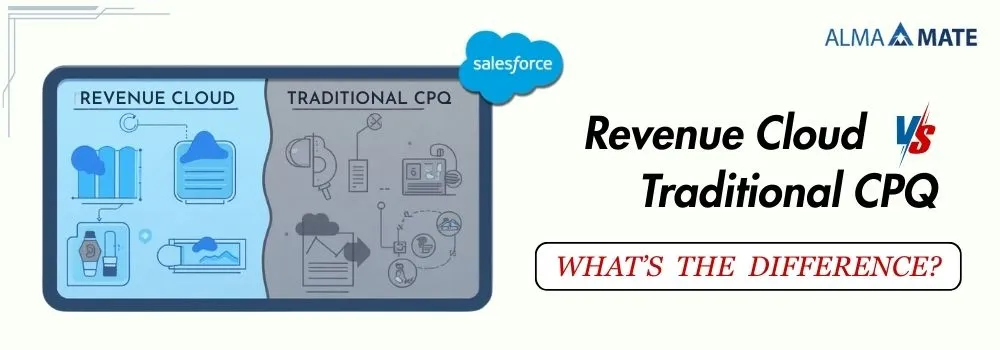
Revenue Cloud vs. Traditional CPQ: Key Comparisons
>> Pricing and Quoting Accuracy
Now, let’s get into the bare-knuckle comparison: Revenue Cloud vs. Traditional CPQ. Traditional CPQ is basically a glorified calculator. It gets you a quote, sure, but if you want to manage subscriptions or change prices on the fly for, say, your customers in Tokyo and Toronto? Good luck. Revenue Cloud? It’s built for that. AI and automation mean quotes and prices update in real time, approvals happen way faster, and you spend way less time untangling contract renewals or billing headaches.
>> Automation and Workflow Efficiency
AI and automation mean quotes and prices update in real time, approvals happen way faster, and you spend way less time untangling contract renewals or billing headaches. This streamlined efficiency is where Revenue Cloud outpaces traditional CPQ, which often requires significant manual effort and slows down the sales process.
>> Integration with CRM and ERP Systems
Integration? Old CPQ is usually bolted on, which means syncing nightmares. Revenue Cloud’s native—so your CRM, ERP, analytics, all talk to each other without you playing IT firefighter.
>> Scalability and Flexibility
It scales, too—handling multiple currencies, languages, and complex product lines. This adaptability makes it easier for businesses to expand into new regions or markets without the friction often caused by traditional CPQ tools.
>> Customer Experience and Personalization
From the customer’s perspective, it’s not just your sales rep clicking buttons. Revenue Cloud sets up self-service portals, gives partners better tools, and uses AI to serve up deals that actually make sense for the buyer.
>> Analytics and Forecasting
Analytics? Forget the rear-view mirror. With Revenue Cloud, you get forecasting and insights that help you plan for what’s next, not just stare at what already happened.
Comparison of the deployment of CPQ with the deployment of Revenue Cloud
>> CPQ Deployment
Focus & Scope
- All about sales cycles—think: quoting, product bundles, discounts, and slick proposals.
- The Finance vertical is barely involved. Maybe a quick cameo for number checks.
- Mostly lives inside Sales Cloud, with the occasional ERP integration for price or product data.
Timeline & Complexity
- These are streamlined and easy to use.
- Typically, a rollout takes 3 to 6 months at the most.
Risks & Challenges
- Main worries? Confusing product rules or a clunky interface may offend the sales team.
Business Impact
- Fast returns.
- Fewer quoting mistakes, more deals closed, sales folks smile for a change.
>> Revenue Cloud Deployment
Scope & Reach
- CPQ is just one act—the whole show includes quoting, subscriptions, billing, payments, and revenue recognition on a relatively larger scale.
- Now you’ve got finance, accounting, legal, customer success: basically, everyone with a stake in the cash flow.
Integration Overload
- Needs to connect with everything: ERP, tax engines, payment gateways, and compliance tools.
Timeline & Complexity
- Forget quick wins.
- Rollout usually takes 6 months to a year (sometimes longer).
Risks & Pitfalls
- Mess up here and you’re not just annoying sales—you’re risking billing errors, revenue recognition fiascos, or compliance disasters (think ASC 606, IFRS 15).
- Testing and change management? Absolutely critical.
Business Impact
- Slow burn but big payoff.
- Enables subscription models, recurring revenue, automated compliance, and a seamless customer experience from start to finish.
Why Businesses Are Making the Switch
>> Driving Revenue Growth
Man, the difference Revenue Cloud makes? It’s like flipping on the nitro for your sales engine. Suddenly, you’ve got upselling, cross-selling, all those sweet subscription models that old-school CPQ just couldn’t hack. Seriously, businesses aren’t just raking in more cash—they’re seeing cash flow turn steady and predictable. Forget scraping by on one-and-done deals. With Revenue Cloud, subscriptions and add-ons are baked in. Upsells are just part of the flow. That stability? Just priceless.
>> Shortening the Sales Cycle
In short, why are businesses ditching the old CPQ? Simple: Revenue Cloud makes sales cycles stupidly fast. Automation and smart workflows mean quotes and sign-offs take hours, not days, and suddenly everyone’s wondering why they ever put up with the old way.
Nobody likes a dragged-out sales cycle. Revenue Cloud automates approvals and billing, throws in a guided selling path, and suddenly deals are closing before you can say “where’s my commission check?” In industries where speed means survival, that’s huge.
>> Improving Compliance and Governance
Let’s talk compliance now. Revenue Cloud takes all that regulatory headache—quotes, pricing, contracts, whatever—and makes it… not your problem anymore. No more sweating audits or trying to untangle revenue recognition nightmares. Revenue Cloud steps in and automates the whole thing. International standards? Covered. Financial risks? Shrinking faster than employees’ average attention span nowadays!
>> Enhancing Customer-Centric Selling
But here’s what’s really wild: it’s not just about swapping out some clunky system for a shinier one. The whole approach shifts. Now, you’re actually selling the way people want to buy—tailored, frictionless, basically on their terms. Think: Amazon-level smoothness, even if you’re selling jet engines or MRI machines. Revenue Cloud actually delivers on those expectations instead of just talking a big game.
Real-World Use Cases
>> Industries Benefitting Most from Revenue Cloud
The proof’s in the pudding—or, you know, in the case studies. Tech companies are juggling wild subscription models and usage-based billing, all while keeping everything tight for audits.
Manufacturers? They can whip up custom quotes for Frankenstein products in a blink. Telecoms? Imagine sorting out billing for millions of lines and partners without losing your sanity. Yeah, Revenue Cloud’s doing that.
>> Success stories and Case studies
- SaaS: They’re finally taming the subscription beast—renewals, upgrades, usage billing, you name it.
- Telecom: Bundles galore—hardware, data, and service plans, all without melting the billing system.
- Manufacturing: Massive product catalogs, global quoting—handled.
- Healthcare: Compliance-heavy contracts? Actually manageable.
Big names? Zoom is riding the subscription rocket, Schneider Electric syncing up teams worldwide, and HP is going all-in on hardware-as-a-service. These aren’t just random wins—they’re proof that Revenue Cloud lets you flex, fast.
Challenges in Transitioning
Alright, let’s keep it real: switching to Revenue Cloud is no cakewalk. Dragging old data out of legacy systems is a slog. Integrations can get gnarly/messy—especially if you’re bolting into ancient ERPs. And, folks don’t love change. You’ll get some eye rolls and “but we’ve always done it this way!” vibes.
Customization? That’s a double-edged sword. If you try to force all your old processes into the new system, you’re just asking for headaches.
The upside? These bumps aren’t dealbreakers. With a smart rollout (think: start small, don’t dump everything at once), solid training, and the right partners, you can dodge most of the land mines. Get your IT and finance teams talking early, bring in some Salesforce pros, and for the love of all things holy—test everything before you go live.
>> Common Obstacles to Migration:
- Data migration drama
- Grumpy employees resisting change
- Integrating with crusty old ERP systems
- Sticker shock on upfront costs
>> Best Practices for a Smooth Transition
- Roll out in stages, not all at once
- Get your sales crew hands-on with real workshops, not just PowerPoints
- Align your IT and finance folks before things get messy
- Partner with people who actually know what they’re doing (hint: certified Salesforce consultants)
So yeah, it’s a journey. But if you do it right, you’ll wonder how you ever lived without it.
The Future of CPQ and Revenue Management
Alright, let’s stop pretending like the future of CPQ and revenue management is a mystery. It’s all about AI, automation, and making everyone’s life a heck of a lot easier (except maybe for those folks who love spreadsheets!). Salesforce’s Revenue Cloud is already rolling out AI-powered recommendations for pricing, cross-sells, and contract renewals. It’s honestly a little freaky how fast this stuff is moving. In a couple of years? You’ll probably see sales systems that know what your customers want before they do.
Manual tasks? Yeah, those are going the way of dial-up internet. Automation is swooping in, letting sales teams focus on the fun stuff—like actually growing the business instead of wrestling with paperwork. Advanced analytics are about to change the whole game for forecasting and financial planning, too.
Bottom line: companies jumping on solutions like Revenue Cloud now are gonna crush it. The old-school CPQ tools? They’ll stick around for basic quoting, but keeping up with the new pace? That may not happen. The writing’s on the wall: the future belongs to platforms that mix brainpower, flexibility, and serious scaling across the entire revenue cycle.
>> Role of AI and Automation
AI in CPQ isn’t just a fancy buzzword anymore—it’s legit. We’re talking smart bundle recommendations, predicting what clients might want next, and even optimizing discounts without you having to lift a finger. Makes it a whole lot easier for new sales reps to get up to speed, too.
>> Predictive Selling and Revenue Intelligence
Forget reacting to stuff after it happens. With Revenue Cloud, companies can actually see what’s coming—and change course before it’s too late. Like, imagine knowing a customer’s about to bail, and you can slide in with a sweet retention deal before they ghost you. That’s the level we’re talking about.
>> Long-Term Business Impact
As everyone moves to subscription models (because, apparently, we all just love paying monthly now), CPQ isn’t just about quoting anymore. It’s morphing into full-on Revenue Lifecycle Management. First movers? Yes, they’re going to have an upper hand.
Conclusion
Let’s be real: the whole Revenue Cloud vs. old-school Salesforce CPQ debate is bigger than just picking a shiny new gadget. It’s about setting your business up to win. Traditional CPQ was awesome back when fax machines roamed the earth, but these days? Not quite cutting it. Salesforce Revenue Cloud takes things up a notch, tying together quoting, billing, and revenue recognition—like the multi-utility tool of revenue management.
Switching isn’t just a software upgrade. You’re baking agility, compliance, and customer-obsession right into your business DNA. The comparison is pretty obvious once you dig in. Old CPQ brought some much-needed order to chaotic quoting, but in today’s “blink and you’ll miss it” market, it’s starting to show its flaws.
Revenue Cloud is the next chapter—quoting, billing, subscriptions, analytics, all in one place and built to scale. Also, switching to Salesforce Revenue Cloud isn’t just a tech thing—it’s a strategic move. You’re not only keeping up; you’re pulling ahead. Companies that get on board now are building for the long haul, while the laggards will find it hard to catch up in the long run.
Revenue models are highly dynamic, and if you want to future-proof your business and actually deliver for your customers at every step, Revenue Cloud is looking like the smartest bet on the table.
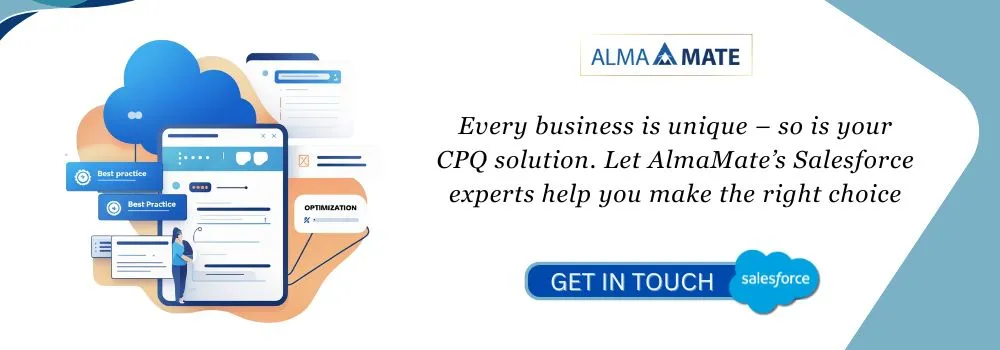
Still wondering whether Revenue Cloud or Traditional CPQ is the right move for your business?
This is where the right guidance makes all the difference. At AlmaMate Info Tech, we don’t just provide Salesforce consulting—we partner with organizations to design and implement seamless, customized Salesforce development solutions that fit their exact business needs. As a trusted Salesforce Development Company with proven expertise, we specialize in delivering innovative strategies that help businesses streamline quoting, billing, and revenue management while ensuring scalability and long-term growth.
Whether you’re considering a switch to Revenue Cloud or optimizing your existing CPQ setup, AlmaMate provides the right blend of technology and strategy through our expert Salesforce consultancy services. We ensure that every transition is smooth, future-proof, and tailored to your business goals. By combining deep Salesforce knowledge with client-focused delivery, we empower organizations to move beyond short-term fixes and embrace long-term digital transformation.

